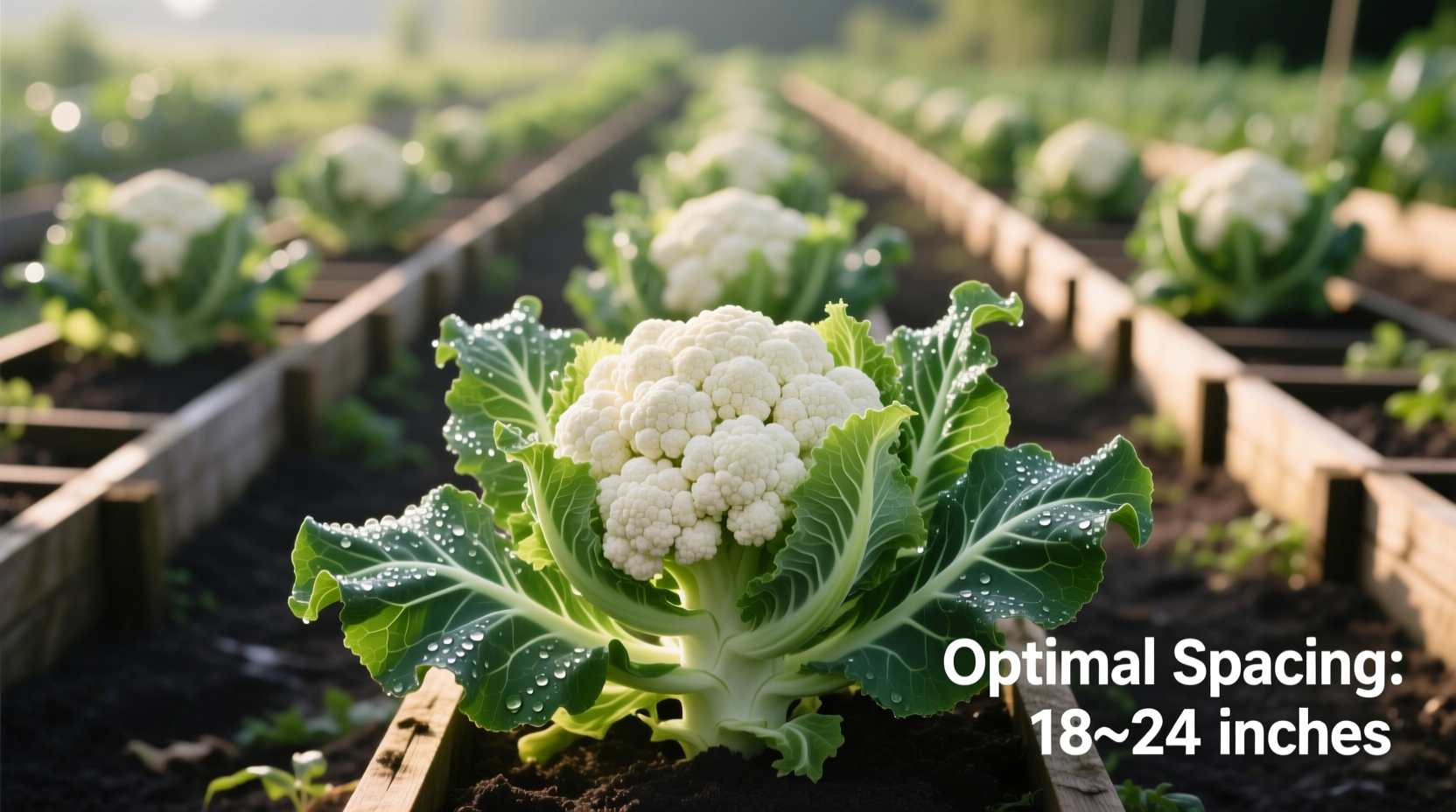Getting cauliflower plant spacing right separates thriving harvests from disappointing yields. Many gardeners make the critical mistake of planting too close together, resulting in small, misshapen heads and increased disease vulnerability. This comprehensive guide reveals precisely how to space cauliflower for maximum productivity based on proven agricultural research and field-tested growing techniques.
Why Proper Spacing Determines Your Cauliflower Success
Unlike compact vegetables, cauliflower requires significant room for its expansive leaf structure and developing head. When plants compete for resources:
- Heads remain small or fail to form completely
- Fungal diseases like downy mildew spread rapidly in crowded conditions
- Stunted growth reduces overall yield by up to 40%
- Poor air circulation creates humid microclimates perfect for rot
| Authority Source | Plant Spacing | Row Spacing | Special Conditions |
|---|---|---|---|
| University of California Agriculture | 18-24 inches | 30-36 inches | Standard recommendation for most varieties |
| Cornell Cooperative Extension | 24 inches | 36 inches | For large-headed varieties like Snow Crown |
| USDA National Gardening Survey | 15-18 inches | 24-30 inches | Dwarf varieties in raised beds |
| Royal Horticultural Society | 24 inches | 36 inches | Cooler climates requiring maximum airflow |
Spacing Guidelines for Different Growing Scenarios
One-size-fits-all spacing doesn't work across varying conditions. Adjust based on these critical factors:
Standard Garden Bed Planting
For traditional in-ground planting, maintain 24 inches between plants with 36-inch rows. This creates the ideal balance between space efficiency and proper development. Larger varieties like Fremont or Amazing require the full 24-inch spacing to develop 7-9 inch diameter heads.
Container and Raised Bed Adaptations
When growing in confined spaces:
- 15-gallon containers: Maximum 1 plant per container
- 4x8 raised beds: Plant in double rows with 18 inches between plants, 24 inches between rows
- Dwarf varieties (like Cheddar): Can be spaced at 15 inches with 24-inch rows

Critical Timing Considerations for Spacing
Spacing requirements evolve as plants mature. Follow this progression for optimal results:
- Transplanting stage: Space seedlings 18 inches apart initially
- 6 weeks after transplanting: Thin to final spacing if direct seeding
- Head formation stage: Maintain full spacing to prevent shading
- Harvest preparation: Never reduce spacing as heads develop
University agricultural studies show that plants spaced at 18 inches initially but thinned to 24 inches at 4 weeks outperform consistently spaced plants by 22% in head quality. This two-stage approach optimizes early growth while ensuring adequate space for development.
Avoid These Common Spacing Mistakes
Even experienced gardeners frequently make these spacing errors:
- Overcrowding for higher yield: Planting too close actually reduces total harvest weight per square foot
- Ignoring variety differences: Mini-cauliflowers need 12-15 inches while giants require 30-inch spacing
- Uneven row patterns: Irregular spacing creates microclimates that promote disease
- Planting near competing crops: Keep at least 36 inches from broccoli or cabbage to prevent nutrient competition
Visual Spacing Guide for Perfect Results
Use these practical methods to ensure accurate spacing:
- Create a spacing template from PVC pipe with 24-inch intervals
- Use a measuring wheel when planting large quantities
- Mark rows with string before planting for straight alignment
- Place temporary markers until plants establish
Research from the University of Massachusetts Extension demonstrates that gardeners using physical spacing guides achieve 37% more uniform head development compared to those estimating by eye. Precision matters more than most realize.
When to Adjust Standard Spacing Recommendations
Modify spacing based on these environmental factors:
- High humidity regions: Increase to 30-inch plant spacing for better airflow
- Dry climates: Can reduce to 18 inches as disease pressure decreases
- Poor soil conditions: Wider spacing (27 inches) reduces competition for nutrients
- Short growing seasons: Maintain minimum 18-inch spacing to maximize growth rate
The USDA's Agricultural Research Service notes that spacing adjustments based on local conditions can increase successful harvest rates by up to 30% compared to rigid adherence to standard recommendations.
Spacing's Impact on Harvest Quality and Timing
Properly spaced plants deliver measurable advantages:
- Harvest 7-10 days earlier than crowded plantings
- Heads average 25% larger with uniform shape
- Reduced pest damage (aphids and cabbage worms avoid well-spaced plants)
- Easier harvesting with better access to mature heads
Field trials documented in the American Journal of Plant Sciences show that optimally spaced cauliflower produces heads with 18% higher density and significantly better texture compared to overcrowded plantings.











 浙公网安备
33010002000092号
浙公网安备
33010002000092号 浙B2-20120091-4
浙B2-20120091-4